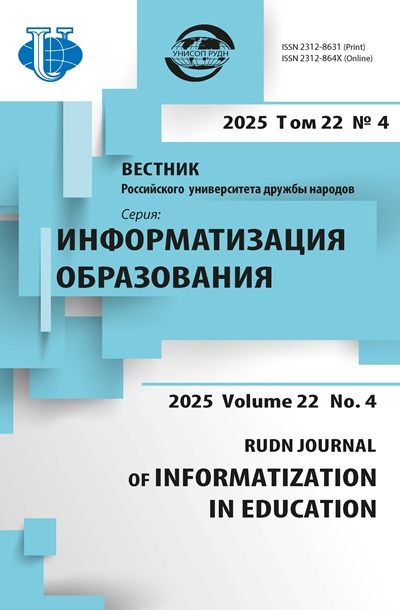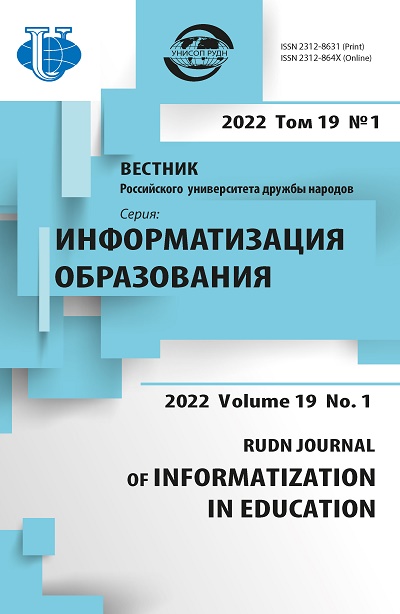Том 19, № 1 (2022)
- Год: 2022
- Статей: 5
- URL: https://journals.rudn.ru/informatization-education/issue/view/1529
- DOI: https://doi.org/10.22363/2312-8631-2022-19-1
Весь выпуск
ГЛОБАЛЬНЫЕ АСПЕКТЫ ИНФОРМАТИЗАЦИИ ОБРАЗОВАНИЯ
Метод пирамиды в условиях цифровизации образования
Аннотация
Постановка проблемы. Цифровая трансформация образования обуславливает необходимость новых подходов к разработке цифровых образовательных ресурсов, проектированию учебных и научных проектов. Они должны обеспечивать высокую степень персонификации обучения, структурировать процессы организации, мониторинга и оценки качества образовательных продуктов и результатов. В процессе цифровизации образования расширяются цели образовательной системы. В этой связи работа посвящена обоснованию метода пирамиды для решения образовательных задач, соответствующих современным требованиям цифрового общества. Методология. Проведенный анализ метода пирамиды, разработанный Барбарой Минто, применяемый в проектировании дорожных карт развития бизнеса и способствующий развитию структурного мышления как одного из самых востребованных качеств современного специалиста, позволил выделить ряд преимуществ и достоинств в случае трансформации этого метода для решения образовательных проблем. В частности, метод удобен для разработки учебного контента в формате пирамидального дерева знаний, формирования четких планов и заданий обучаемым по темам курсовых и дипломных работ, мониторинга и оценки качества образовательных результатов, сложных систем и объектов. Результаты. Показаны примеры применения метода пирамиды для создания перевернутых учебных ресурсов, повышения интерактивности при проведении лекций и практических занятий, организации контроля и самоконтроля знаний обучаемых, мониторинга и оценки качества образовательных ресурсов и систем. Заключение. Метод пирамиды облегчает процесс создания цифровых образовательных ресурсов, в максимальной степени соответствующих особенностям современного поколения и удовлетворяющих принципам персонификации обучения. Его освоение и применение в учебной деятельности самими обучающимся способствует развитию у них структурного мышления.
 7-19
7-19


Цифровая трансформация: основные подходы к определению понятия
Аннотация
Постановка проблемы. Изменения в обществе в связи с многообразием использования информационно-коммуникационных технологий привели к активному использованию понятия «цифровая трансформация». Сложное полисемичное понятие описывает многофакторное явление, что обуславливает необходимость использования междисциплинарного подхода к анализу его содержания. В рамках исследования понятие «цифровая трансформация» изучалось в трех разрезах: философском, культурологическом и аксиологическом. Методология. Основным методом выбран библиометрический анализ российской электронной базы со встроенными средствами анализа. Количественные и качественные характеристики открытых источников по теме «Цифровая трансформация» анализировались с помощью закрытых систем поиска и машинного анализа больших текстов, таких как Microsoft Academic Graph и Dimensions.ai. Проведен контент-анализ и тематический мониторинг имеющихся публикаций по ключевым словам «цифровизация образования», «цифровая трансформация», «цифровая трансформация высшего образования». Оценка уровня заинтересованности данной проблематикой осуществлена по статистике запросов с использованием ресурса wordstat.ru. Результаты. Рассмотрение цифровой трансформации в широком контексте позволило сформулировать определения с использованием двух подходов: философского и культурологического. Аксиологический подход задает широкую рамку обсуждения и требует дополнительных исследований. Заключение. В процессе выполнения исследовательской работы с использованием различных средств статистического анализа сделана выборка как российских, так и зарубежных работ по проблеме цифровой трансформации. Рассмотрены три подхода к анализу цифровой трансформации, сформулированы определения и обоснована необходимость исследования трансформации образования с использованием антропологического подхода.
 20-28
20-28


ЦИФРОВЫЕ ТЕХНОЛОГИИ В ИНКЛЮЗИВНОМ ОБРАЗОВАНИИ
Исследование доступности веб-сайтов вузов России для лиц с ограничениями по зрению
Аннотация
Постановка проблемы. В современном мире увеличилась востребованность веб-сайтов вузов. По закону в России на образовательные сайты внедрены версии для слабовидящих. Целью исследования стала оценка (преимущественно автоматическим способом) данных сайтов на предмет доступности и качества версий для слабовидящих, а также выявление лучшего способа реализации таких решений и создания доступных сайтов в целом. Методология. Разработана программная система сбора метрик с сайтов в двух версиях: обычной и для слабовидящих. Сравниваются количественные метрики на основе html-кода и визуального анализа скриншотов главных страниц. Показатели получены ручным тестированием. Результаты. Изучены данные 571 сайта вузов, представленные в общем доступе. Произведен корреляционный анализ метрик. Сделана оценка качества работоспособности версий для слабовидящих, составлены рекомендации к технической реализации и стандартному набору настроек версий для слабовидящих. Собрана статистика используемых готовых решений, инструментов разработки сайтов. Заключение. Выявлены актуальные проблемы в области доступности образовательных сайтов в России, сформулированы предложения по проведению оценки и разработке доступных сайтов. Рекомендации могут использоваться как одна из инструкций для разработки или проверки версий для слабовидящих.
 29-44
29-44


ПЕДАГОГИКА И ДИДАКТИКА ИНФОРМАТИЗАЦИИ
Определение сфер компетенции учителей общего образования
Аннотация
Постановка проблемы. Представлены экспериментальные данные по областям компетенции учителей. Методология. Исследовательский подход к непрерывному профессиональному обучению основан на комплексной прикладной исследовательской стратегии, сочетающей как количественные, так и качественные методы исследования. Результаты. Анализ позволил определить области компетенции учителей в непрерывном профессиональном обучении: реляционная компетенция, преподавательско-учебная компетенция, управленческая компетенция, компетенция в области проектирования и планирования, специализированная когнитивная компетенция, компетенция в области оценки и мониторинга. Приведены экспериментальные данные на этапе поиска педагогического эксперимента, в котором участвовало 888 человек, разделенных на две выборки: обучающая (441 человек) и контрольная (447 человек). Заключение. Предложенная система оценки, послужившая основой для определения областей компетенции учителей, содержит следующие компоненты: критерии оценки, уровни успеваемости, показатели успеха, степень оценки и дескрипторы.
 45-53
45-53


ВЛИЯНИЕ ТЕХНОЛОГИЙ НА РАЗВИТИЕ ОБРАЗОВАНИЯ
Развитие научных знаний студентов по компьютерному моделированию при обучении обратным задачам для дифференциальных уравнений
Аннотация
Постановка проблемы. В настоящее время высшая школа предоставляет студентам физико-математических направлений подготовки фундаментальные предметные знания, формирует профессиональные компетенции, развивает творческие способности и креативность, учит использовать современные компьютерные технологии для решения прикладных задач. Одной из таких учебных дисциплин, при обучении которой студентов учат применять компьютерные технологии при решении прикладных математических задач, является учебный курс «Обратные задачи для дифференциальных уравнений». Данная дисциплина преподается в некоторых вузах России в виде курсов по выбору с 70-х годов XX века. Учебный материал курса включает передовые результаты исследований по обратным задачам, принадлежащие специалистам разных стран, таких как Германия, Италия, Китай, Швеция, Нидерланды, Россия, Япония и другие страны дальнего зарубежья. На практических занятиях уделяется большое внимание применению компьютерного моделирования для исследования прикладных задач. Это обстоятельство предполагает разработку учебных материалов с учетом профессиональной подготовки студентов вузов, в которых необходимо уделить внимание использованию компьютерного моделирования при решении математических моделей обратных задач. Методология. Реализация обучения студентов вузов физико-математических направлений подготовки должно учитывать современные научные достижения мировой науки в области обратных задач с использованием компьютерного моделирования и реализовывать на учебных занятиях передовые педагогические технологии. Результаты. При исследовании обратных задач студенты приобретают научные знания по компьютерному моделированию и осваивают его широкие возможности. Заключение. Наличие научных знаний в области компьютерного моделирования и практического опыта его применения для решения обратных задач дает студентам большие преимущества, возможности стать успешными специалистами в области прикладной математики и быть востребованными на рынке труда в разных сферах человеческой деятельности.
 54-61
54-61
















